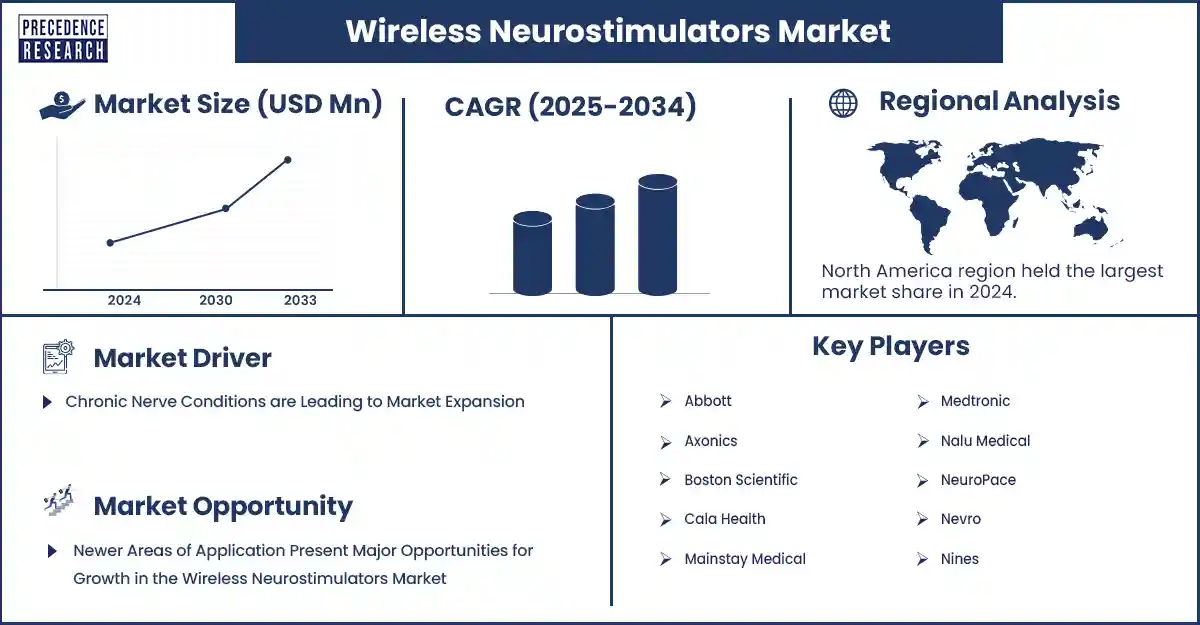Wireless Neurostimulators Market Revenue and Forecast by 2033
Wireless Neurostimulators Market Revenue and Trends 2025 to 2033
The global wireless neurostimulators market report highlighting growth drivers, technological innovations, and emerging opportunities in neurological care. The market growth is driven by increasing demand for minimally invasive neuromodulation therapies, advances in wireless power and closed-loop controllers, and growing prevalence of neurological and chronic pain disorders.

How do neurostimulation devices work, and what factors are impacting the market?
Key factors impacting the growth of the wireless neurostimulators market include rising prevalence of chronic pain, neurological disorders, and an aging population, all of which increase the demand for effective pain management solutions. Neurostimulation devices work by delivering mild electrical impulses to specific parts of the nervous system to modulate neural activity. These devices target nerves or brain regions involved in pain, movement, or various neurological functions.
The wireless neurostimulators market involves devices that use electrical impulses to treat various neurological conditions without the need for wires. These devices offer several advantages, including increased patient mobility, reduced risk of infection, and enhanced comfort. Technological advancements, such as miniaturization and improved battery life, are also driving market growth. Furthermore, the rising preference for less invasive and more convenient treatment options is boosting the adoption of wireless systems.
Segment Insights:
- By stimulation modality / therapeutic approach, the spinal cord stimulation (SCS) segment dominated the market in 2024, owing to its proven effectiveness in managing chronic pain, particularly in patients unresponsive to conventional therapies.
- By product type / system component, the implantable pulse generators (IPGs) segment dominated the market primarily because they are the key implantable elements in stimulation and pacing therapy.
- By power & wireless technology, the rechargeable battery with inductive wireless charging segment led the market in 2024 due to its convenience, longer device lifespan, and improved patient compliance.
- By mode of operation, the open-loop segment sustains dominance in the wireless neurostimulators market. This is due to its simpler design, lower cost, and proven effectiveness in managing a wide range of neurological conditions.
- By indication / clinical application, the chronic neuropathic pain / failed back surgery syndrome (FBSS) led the market due to the high prevalence and persistent nature of these conditions, which often resist conventional treatments.
- By implant type / form factor, the fully implantable systems segment dominated the market in 2024, as they are the most integrated, reliable, convenient, and discreet systems. They offer continuous, discreet therapy with fewer lifestyle disruptions, which enhances patient compliance and quality of life.
- By clinical mode / control granularity, the multi-site/multi-lead programmable stimulation segment dominated the market in 2024, as it is the most preferred option due to its ability to control stimulation within tissue and target multiple nerve areas simultaneously.
- By end-user / treatment setting, the hospitals & academic medical centers (tertiary care) segment dominated the market in 2024 due to their involvement in clinical research and trials, which accelerated the adoption of cutting-edge wireless neurostimulators.
- By distribution & commercial channel, the direct sales segment dominated the market in 2024, as it enabled manufacturers to maintain closer relationships with healthcare providers and patients, thereby ensuring better product education, customization, and support.
Regional Insights:
North America led the wireless neurostimulators market in 2024, driven by its robust healthcare infrastructure, favorable reimbursement policies, and a substantial existing patient population. The presence of leading medtech companies in the region further fuels market growth. The U.S., in particular, serves as a central hub for regulatory approvals, research and development, and commercial launches, capturing a substantial portion of new revenue growth.
Asia Pacific is expected to experience significant growth, driven by expanding healthcare access, a rise in neurological disorders, and increasing patient awareness. Supportive regulatory frameworks for medical devices are also contributing to this growth. Countries like China, Japan, and India offer promising opportunities for wireless neurostimulator manufacturers to expand their market presence, driven by the increasing prevalence of chronic pain and neurological disorders, as well as an aging population.
Wireless Neurostimulators Market Coverage
| Report Attribute | Key Statistics |
| Quantitative Units | Revenue in USD million/billion, Volume in units |
| Largest Market | North America |
| Base Year | 2024 |
| Regions Covered | North America, Europe, Asia-Pacific, Latin America, and Middle East & Africa |
Wireless Neurostimulators Market Companies
- Abbott
- Axonics
- Boston Scientific
- Cala Health
- Mainstay Medical
- Medtronic
- Nalu Medical
- NeuroPace
- Nevro
- Nines
- Precision Neuroscience
- Saluda Medical
- SetPoint Medical
- SPR Therapeutics
- Stimwave
Recent Development:
- In February 2025, Medtronic secured U.S. FDA approval for its BrainSense Adaptive DBS system, enabling closed-loop, real-time adjustment of stimulation based on brain signals, marking the world’s first adaptive DBS offering.
(Source- https://www.biospectrumasia.com)
Get this report to explore global market size, share, CAGR, and trends, featuring detailed segmental analysis and an insightful competitive landscape overview @ https://www.precedenceresearch.com/sample/6876
You can place an order or ask any questions, please feel free to contact at sales@precedenceresearch.com |+1 804 441 9344